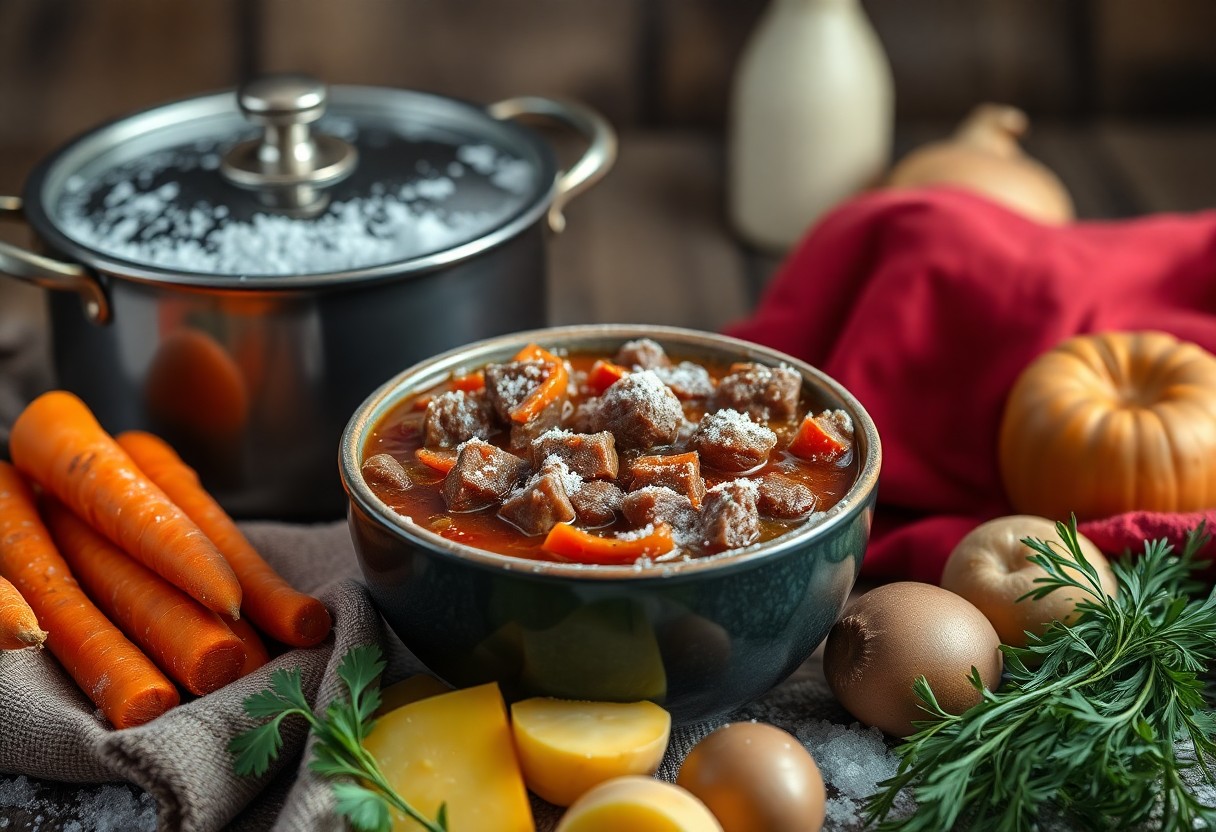Just when you think you’ve mastered the art of making delicious beef stew, you might wonder if you can make your leftovers last longer by freezing them. Understanding how to properly freeze and thaw beef stew can help you enjoy this hearty dish even when you’re short on time. In this post, you’ll learn the best practices for preserving flavor and texture when freezing your delicious beef stew, so you can enjoy it whenever the craving strikes.
Benefits of Freezing Beef Stew
While freezing beef stew offers a variety of advantages, it primarily allows you to save time and money. By preparing larger batches and storing leftovers, you can minimize food waste and ensure you always have a hearty meal on hand for busy days. Additionally, freezing helps maintain the nutritional value of the stew, making it a convenient option for healthy eating.
Preserving Flavor and Texture
With proper freezing techniques, you can preserve the rich flavors and textures of your beef stew. The freezing process halts the degradation of ingredients, allowing you to enjoy the same delicious taste when you defrost and reheat it later. Ensure you use airtight containers or freezer bags to minimize air exposure and maintain the stew’s quality.
Convenience for Meal Preparation
Meal prep becomes a breeze when you freeze beef stew in portions. You can easily grab a pre-portioned container before heading to work or school, making your day smoother and more organized. Rather than spending time cooking every day, you can simply reheat and enjoy a wholesome meal in minutes.
At the end of a long day, having a portion of beef stew ready to go means you can spend less time in the kitchen and more time enjoying your meal or spending time with family. This convenience can significantly enhance your weeknight dinners, allowing you to serve a nutritious homemade dish without the stress of preparation.
How to Properly Freeze Beef Stew
Some simple steps will help you freeze your beef stew effectively, ensuring its quality when you thaw it later. Start by allowing your stew to cool completely before freezing. Use airtight containers or heavy-duty freezer bags to store the stew, as this will prevent freezer burn. Be sure to leave some space at the top of the container or bag, as liquids expand when frozen.
Preparation Tips
Before you freeze beef stew, take the time to prepare it properly. Follow these simple tips:
- Cool the stew to room temperature.
- Divide it into portion-sized containers.
- Label each container with the date and contents.
After prepping, you can place it in the freezer for future use.
Storage Methods
Storage of your beef stew can greatly influence its taste and texture upon reheating. Using the right container is vital; opt for freezer-safe options that provide an airtight seal. You can also use sturdy aluminum foil or plastic wrap to cover the containers, minimizing air exposure. It’s advisable to freeze your stew within a few hours of cooking for the best quality. The ideal frozen beef stew should be consumed within three to six months for optimal flavor.

Thawing Frozen Beef Stew
The best way to thaw your frozen beef stew is by planning ahead. You can transfer it from the freezer to the refrigerator and let it thaw gradually over 24 hours. This method not only ensures your stew retains its flavors but also maintains food safety. If you’re short on time, you can submerge your sealed container of stew in cold water, changing the water every 30 minutes until it’s fully thawed.
Safe Thawing Techniques
Any method you choose to thaw your beef stew should prioritize safety. The refrigerator method is the safest, as it keeps the stew at a consistently safe temperature. The cold water method offers a quicker alternative, but you must ensure the stew remains sealed to prevent contamination. Never thaw beef stew at room temperature, as this can encourage bacterial growth.
Reheating Instructions
After thawing, the next step is to reheat your beef stew properly. You can reheat it on the stovetop over medium heat, stirring occasionally, or in the microwave. Make sure it reaches an internal temperature of 165°F for safe consumption.
Frozen beef stew can be reheated easily either on the stovetop or in the microwave. If using the stovetop, pour your thawed stew into a pot, heat over medium heat, and stir periodically until it’s steaming and at least 165°F. For microwave reheating, cover your stew in a microwave-safe container and heat in short intervals, stirring in between, to ensure even heating. Adjust the times according to your microwave’s wattage until your stew is piping hot throughout.
Common Mistakes to Avoid
Despite the convenience of freezing beef stew, there are common mistakes that can affect its quality. One of the biggest pitfalls is failing to properly package your stew, which can lead to freezer burn and off-flavors. Additionally, freezing it for too long can impact both the taste and texture, making your hearty meal less enjoyable when you finally dig in. Being mindful of these errors will ensure your beef stew is both safe and delicious when it’s time to enjoy it again.
Improper Packaging
Below are some guidelines for proper packaging to avoid freezer burn and spoilage. Use airtight containers or heavy-duty freezer bags, making sure to remove as much air as possible before sealing. Label each container with the date so you can keep track of how long it has been in the freezer. Properly packaging your beef stew will significantly enhance its longevity and flavor when defrosted.
Freezing for Too Long
Packaging your beef stew properly is just one aspect; be mindful of how long it remains in the freezer. While freezing can extend the shelf life of your stew, keeping it frozen for an excessive duration can result in a decline in quality. The flavors may dull, and the texture could become grainy. To enjoy the best taste and texture, aim to consume your frozen beef stew within three to six months for optimal freshness.
With careful attention to how long you freeze your beef stew, you can enjoy a flavorful and satisfying meal whenever you choose. A good rule of thumb is to mark your containers with both the date of freezing and the recommended use-by date. This way, you can ensure that you are consuming your stew at its best and not letting it linger too long in your freezer.
Nutritional Considerations
Not only is beef stew a comforting meal, but it also offers a variety of nutritional benefits. Rich in protein and packed with vegetables, this dish can contribute to a balanced diet. However, it’s imperative to consider your portion sizes, ingredients, and potential added fats or sugars that might modify its health benefits. Ensuring that you use lean cuts and plenty of colorful vegetables can enhance the nutritional quality of your beef stew.
Impact on Health Benefits
Above all, the health benefits of beef stew can vary based on how you prepare it. The use of fresh vegetables boosts the fiber and vitamin content, while lean cuts of beef help maintain a healthier profile. Additionally, homemade beef stew allows you to control the fat and sodium levels, ensuring you get the right nutrition without unnecessary additives.
Portion Control Tips
Benefits of portion control in beef stew include preventing overeating and ensuring that you enjoy your meals without guilt. To maintain mindful portion sizes, consider the following tips:
- Use smaller bowls to serve your stew.
- Measure out your portions before serving.
- Store leftovers in individual containers for easy access.
Any strategy that helps you control portions will enhance your enjoyment of this hearty dish.
A few additional strategies to manage portion control include being aware of your hunger cues and slowing down while eating. This practice helps you better recognize when you’re satisfied. Consider these additional tips:
- Pair your beef stew with a side salad or steamed vegetables.
- Limit toppings like cheese or crackers to a small serving.
- Pack away seconds immediately after serving for later.
Any approach that works for you is beneficial in ensuring a balanced and satisfying meal experience.

Frequently Asked Questions
Keep your beef stew’s flavor and texture intact by following proper freezing methods. It’s common to have questions about freezing stews and leftovers; in this section, you’ll find helpful information that will guide you through the process and storage tips to maximize your stew’s shelf life.
Can You Freeze Other Stews?
Before you decide to freeze other types of stews, consider the ingredients used. Most vegetable, chicken, and lentil stews freeze well, but creamy or dairy-based stews may separate when thawed. Make sure to check the specific components of your stew for the best results.
How Long Can Stew Last in the Freezer?
Frequently, stews can be stored in the freezer for up to three months while maintaining their best quality. After this time, they may still be safe to eat, but the texture and flavor could deteriorate as they sit in the freezer.
But it’s crucial to keep in mind that proper packaging plays a significant role in how long your stew can last in the freezer. Use airtight containers or heavy-duty freezer bags to prevent freezer burn and retain moisture. Label your stew with the date it was frozen, so you can track how long it has been stored and ensure you enjoy it while it’s still at its best.
Conclusion
Upon reflecting, you can successfully freeze beef stew to extend its shelf life and enjoy it later. By properly cooling the stew and using airtight containers or freezer bags, you can preserve its flavor and texture. When you’re ready to eat, thaw it safely in the refrigerator before reheating. This allows you to maintain the quality of your delicious beef stew, making it a convenient meal option for busy days.





Leave a Reply